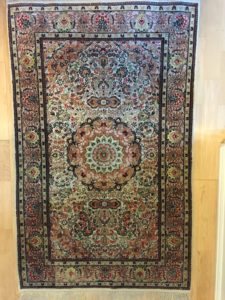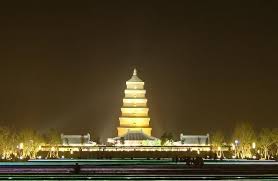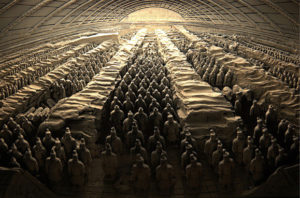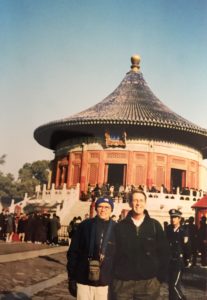Part 3, Temple of Heaven, Xian
Wednesday. After breakfast at the hotel, we drove to one of the hutongs to visit a family home. It felt ackward, as though we were intruders, but our hosts were gracious humble people.
Their home was small and simple, built around a small courtyard. Every inch was cramped and compact. These folks were born here as were the generations before them. The matriarch, 79, looked alert with a little twinkle in her eyes. After a quick visit and a cup of tea, we were off again.
Next, the Temple of Heaven. Four times the size of the Forbidden City but not nearly as grand. The main temple, however, stands 36 meters (117 feet) tall and was built without a single nail. It is a 100% wood structure. It is magnificent as the sun shines on its round blue tiled roof.
An early lunch and an uneventful flight brings us to Xian. There was just the right amount of chaos at arrivals to let you know you have entered the real China, still an emerging country.
The long ride from the airport to the city passed rich and vast agricultural fields reminescent of the California Central Valley or India’s sprawling fields in Rajasthan. Soon we arrive in Xian, a massive city of 7 million. It is dusty, smoggy and heavily congested.
Pollution billowing from smoke stacks in all directions smell worse than it looks. The traffic is beyond belief. Cars, trucks, motorcycles, bikes and wheeled contraptions of all kinds jockey, fearlessly and skillfully, to make their way to their destinations.
We arrive at the city’s North Gates and stumble upon a reinactment of an old welcoming ceremony complete with pomp and costumes. We scurry up the stairs as quickly as possible for the best view. The evening is quickly approaching and the sky is brownish yellow in all directions.
Remarkably the city walls have survived in tact. Guard towers, ancient warning bells and four main gates outline the old borders of the town. Eventually during our visit we we will pass through four gates, each facing either North, South, East or West. These are amazing structures that served important purposes. Each gate was surrounded by a fortified wall with gates on either end. If visitors were deem friendly, they would pass into the city through the second set of gates. If determined to be a foe, they would summarily be slaughtered. This practice was later adopted by the Western world and used for centuries.
We enjoy our first hot pot for dinner. Everyone cooks their plate of meats, vegetables and other goodies in a community pot of broth, then seasons with spicy sauces to their taste.
We finally arrive at the Hyatt Hotel, home for the next two nights. It is a wonderful oasis.
Thursday, The Terra Cotta Warriors.
Another early morning start. Everyone is excited as we arrive at the Xian History Museum only to discover “new season hours” delay the opening time. So we divert to the Wild Goose Budddist Temple, a 1400 year old giant brick pagoda that dominates the temple grounds. The group listens to a history of the temple and shivers through an incense lighting ceremony before returning to the museum.
There is a grand and extensive display of the 23 centuries of history. The bronze pieces are especially impressive, gleaming in the lights. The museum hosts an equally impressive gift shop. We discover the best porcelain treasures to date, the very best pieces have a government seal and certificates of authenticity at very reasonable prices. We buy a blue and white in excellent condition. We are delighted.

After the museum, there is another stop at an old mansion complex now converted to a shopping mecca for visitors to the area. We are tempted by so many beautiful things but discover the most gorgeous silk carpets. We yield to temptation and purchase a small 2.5 ft. x 4 ft. silk carpet for our hallway. We negotiated a 40% discount, a good price, but we were a bit shocked at how much we spent. Newbies!

Note: Good news, that carpet has graced our home for decades and looks as new as the first day.
A “pizza box” lunch on the bus takes is to the main event! The complex where the terra cotta warriors were discovered in 1974 is huge. Pit 1 is the largest and most impressive. We had seen the many documentaries and read about the excavations but the sight of hundreds of 2000 year old statues, each crafted from a real soldier of the day is breathtaking. These life sized guardians still silently standing guard for the Emperor of China is amazing. Estimates are there are still hundreds more still waiting to be freed from their earthly shackles.
The biggest surprise is the individual images. Some stern and gruff, others stowic, gentle or resigned. It is overwhelming by the time we have completed touring Pit 4 where diggings have continued. At the end of the visit we meet the actual farmer who discovered it all.
After a long day we dine on dumplings, a welcomed change, but realize much of the Chinese cuisine we have in SF is better than China (undoubtedly due to the local available ingredients and decades of Chinese cooking talents).
The show that followed dinner would be right at home as a 1936 musical spectacle worthy of Louis B. Meyer. The drummers were our favorite. That said, you could have stored meat in that theater, it was freezing.
Coming next, Part 4, Chengdu, Pandas




Jim, your descriptions and commentary are excellent. How wonderful you have kept these journals! Thanks for sharing your journals.